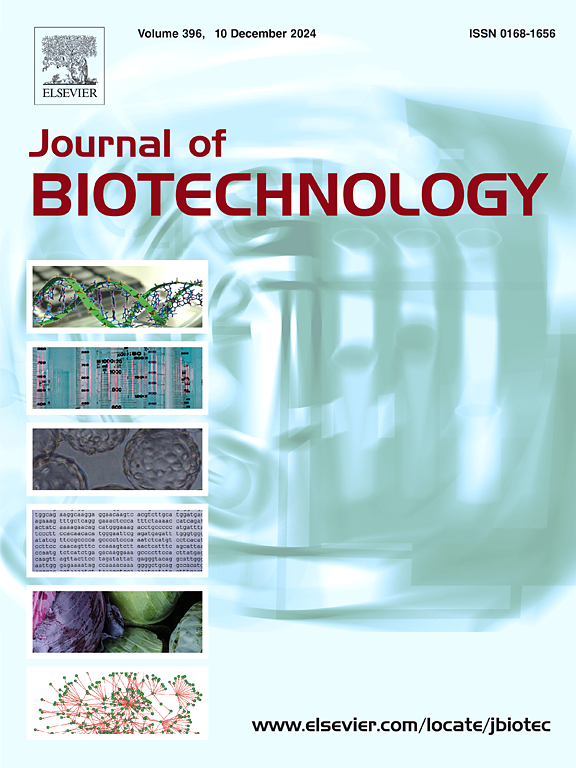肺炎克雷伯菌2,3-丁二醇与支链氨基酸合成途径代谢物分布机制
IF 3.9
2区 生物学
Q2 BIOTECHNOLOGY & APPLIED MICROBIOLOGY
引用次数: 0
摘要
肺炎克雷伯菌是一种众所周知的2,3-丁二醇生产者。2,3-丁二醇合成途径和支链氨基酸(BCAA)合成途径共用丙酮酸合成α-乙酰乳酸的同一步骤。这两种途径在野生型菌株中不会相互干扰。敲除budA(编码α-乙酰乳酸脱羧酶)会阻断2,3-丁二醇合成途径。同时,BCAA合成途径的代谢物(缬氨酸、2-酮异戊酸、2,3-二羟基异戊酸和2-羟基异戊酸)也在积累。然而,budA失活导致代谢物变化的机制尚不清楚。本研究通过离体和体外实验来阐明这一机制。测定了BudA和乙酰羟基酸异构还原酶(IlvC)的动力学参数。与IlvC (Km = 17.98 mM, kcat = 0.68 s−1)相比,BudA对α-乙酸酯具有更高的亲和力,并且具有更高的催化常数(Km = 3.66 mM, kcat = 7.8 s−1)。体外实验表明,敲除budA不影响IlvC活性,反之亦然。在IlvC过表达的细胞中,IlvC活性得到提高,但这并未导致BCAA合成途径代谢物的积累。细胞内IlvC的活性不受培养液中2,3-二羟基异戊酸、2-酮异戊酸或缬氨酸积累的影响。这些结果表明,BudA和IlvC在细胞内的竞争决定了这两条途径之间代谢物的分布。BudA的失活和IlvC的完整导致过量的α-乙酰乳酸流入BCAA合成途径,引起BCAA合成途径代谢物的积累。本文章由计算机程序翻译,如有差异,请以英文原文为准。
Mechanism of metabolites distribution between 2,3-butanediol and branched-chain amino acid synthesis pathways in Klebsiella pneumoniae
Klebsiella pneumoniae is a commonly known 2,3-butanediol producer. 2,3-Butanediol synthesis and branched-chain amino acid (BCAA) synthesis pathways share the same step of α-acetolactate synthesis from pyruvate. Those two pathways do not interfere with each other in the wild-type strain. Knocking out budA (encoding α-acetolactate decarboxylase) blocks the 2,3-butanediol synthesis pathway. Meanwhile, metabolites of the BCAA synthesis pathway (valine, 2-ketoisovalerate, 2,3-dihydroxyisovalerate and 2-hydroxyisovalerate) are accumulated. However, the mechanism underlying the metabolite changes resulting from the inactivation of budA remains unclear. In this study, both ex vivo and in vitro experiments were conducted to elucidate this mechanism. Kinetic parameters of BudA and acetohydroxy acid isomeroreductase (IlvC) were determined. BudA has a higher affinity toward α-acetolactate and has a higher catalytic constant (Km = 3.66 mM, kcat = 7.8 s−1) compared to IlvC (Km = 17.98 mM, kcat = 0.68 s−1). ex vivo experiments showed that IlvC activities were not influenced by knocking out budA and vice versa. IlvC activities were improved in the cells in which ilvC was overexpressed, but this did not lead to the accumulation of metabolites of the BCAA synthesis pathway. The activities of IlvC in the cell were not affected by the accumulation of 2,3-dihydroxyisovalerate, 2-ketoisovalerate, or valine in the broth. These results indicated that the competitiveness of BudA and IlvC in the cell determines the metabolites distribution between those two pathways. The inactivation of BudA and intact IlvC led to the exceeded α-acetolactate flow into the BCAA synthesis pathway, which caused the accumulation of metabolites of the BCAA synthesis pathway.
求助全文
通过发布文献求助,成功后即可免费获取论文全文。
去求助
来源期刊

Journal of biotechnology
工程技术-生物工程与应用微生物
CiteScore
8.90
自引率
2.40%
发文量
190
审稿时长
45 days
期刊介绍:
The Journal of Biotechnology has an open access mirror journal, the Journal of Biotechnology: X, sharing the same aims and scope, editorial team, submission system and rigorous peer review.
The Journal provides a medium for the rapid publication of both full-length articles and short communications on novel and innovative aspects of biotechnology. The Journal will accept papers ranging from genetic or molecular biological positions to those covering biochemical, chemical or bioprocess engineering aspects as well as computer application of new software concepts, provided that in each case the material is directly relevant to biotechnological systems. Papers presenting information of a multidisciplinary nature that would not be suitable for publication in a journal devoted to a single discipline, are particularly welcome.
 求助内容:
求助内容: 应助结果提醒方式:
应助结果提醒方式:


